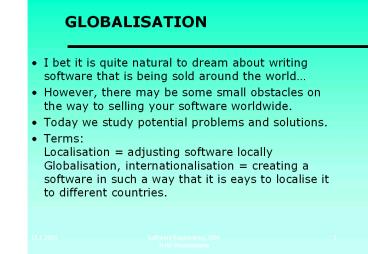Software Engineering 2003 - PowerPoint PPT Presentation
1 / 20
Title:
Software Engineering 2003
Description:
GLOBALISATION I bet it is quite natural to dream about writing software that is being sold around the world However, there may be some small obstacles on the way ... – PowerPoint PPT presentation
Number of Views:114
Avg rating:3.0/5.0
Title: Software Engineering 2003
1
GLOBALISATION
- I bet it is quite natural to dream about writing
software that is being sold around the world - However, there may be some small obstacles on the
way to selling your software worldwide. - Today we study potential problems and solutions.
- TermsLocalisation adjusting software
locallyGlobalisation, internationalisation
creating a software in such a way that it is eays
to localise it to different countries.
2
History
- As a little warm-up, consider the situation about
20 years ago. - At that time there was an increasing interest
into creating software products, which could be
sold to different customers within Finland. - For customising the software, it was important to
put all user interface constants into a place,
where they are easy to change. - Program code is not such a place -gt parameter
files or database are a much better choice.
3
Simple example
- http//java.sun.com/docs/books/tutorial/i18n/index
.html deals with internationalisation issues. - We have a quick look a their example.
- In the example, multilingual texts are managed
using- a locale, identified by a (country,
language) pair- resource bundles, one per
locale,- property files, where strings are
identified by keys - Strings are identified by keywords within a
locale.
4
What should be globalised?
- Messages
- Labels on GUI components
- Online help
- Sounds
- Colors
- Graphics
- Icons
- Dates
- Times
- Numbers
- Currencies
- Measurements
- Phone numbers
- Honorifics and personal titles
- Postal addresses
- Page layouts
- Our example in the previous slide only dealt with
a simple message! - Labels can also be managed in a fairly
straightforward manner, if enough space is
reserved for them. - Now lets have a look at the rest
5
Locales
- As we saw, globalisation in Java was based on the
use of Locales. - A local is identified by a language (compulsory),
country (optional) and variant (optional). - A class, whose behaviour is based on the use of a
locale, is called locale-sensitive. - You can find locales available to a
locale-sensitive class by using the
getAvailableLocales() method. - There is also a default locale for a Java Virtual
Machine, and it can be accessed by
Locale.getDefault() - Different objects may use different locales.
6
Identify what needs to be managed through locales
- As you think about locales, you will find out
that you have - data items such as messages and
sounds, which change altogether with the
locale, and- data items, which remain the same,
but whose formatting changes, e.g. dates and
numbers- possibly data items not to be localised
(internal use, interface to another
application, ). - Design the globalisation - identify which is
which. - Arrange your data items into resource bundles
(e.g. items for the same form in the same bundle,
so that you will not need to load unnecessary
objects).
7
Formats - numbers
- Numbers are formatted differently in different
countries, e.g.345 987,246 France345.987,246
Germany 345,987.246 - US - Java includes a NumberFormat class that can be
used to format numbers, currencies (no exchange
rates, though ) and percentages - You can use the NumberFormat class to both create
formatted strings and parse strings. - You can also provide your own patterns, if this
is not enough for you
8
Dates and Times
- Similarly as with numbers, dates and time are
represented differently. - Also similarly, there is a DateFormat class,
which you can use to create standard date and
time formats. - Here again, you may customise and you may also
define your own names for things such as weekdays
etc.
9
Messages containing variable parts
- Examples- 405,390 people have visited your
website since January 1, 1998. (1) - The
ltdevicenamegt number ltdevicenumbergt has been
activated. (2) - Word order may change between languages, which
may make it impossible to correctly translate
message (1) assuming that it is the text between
the number and the date. - In message (2) the word activated may require
different translation in some languages (e.g.
French) depending on the gender of the word for
the device name. - Basic rule of thumb If you can avoid messages
containing these variable parts, then do so!
10
Class MessageFormat
- With the MessageFormat class you can define a
message template, which gives the message text
and shows where to format the changing data and
how. - With ChoiceFormat, you can choose between strings
using based on a number you give as a parameter
(this is particularly handy for managing plurals).
11
Characters
- US Ascii 7 bit
- ISO 8859-X where X is some digit an 8-bit
system if 8th bit is 0, then the first 7 bits
represent a US Ascii character. - Windows 125x codepages similar to ISO 8859-X,
but not the same of course typical Windows
interoperability nightmare - Unicode meant to represent all characters from
all languages. Needs more bits (usually done with
16) but there are several encoding schemes. Some,
for instance, use two bytes (16 bits) for some
characters and one byte (8 bits) for some - http//www.unicode.org/index.html
12
Chinese and Japanese
- Thousands of symbols.
- Unicode can do but you need more pixels on the
screen as well. - In Japanese there are several writing systems.
- Text input can be done as followed1. The user
types in the word in some phonetic writing
system based on latin characters.2. The system
shows the characters (there may be many)
matching the phonetic writing.3. The user picks
the right character.
13
Korean
- In the Korean writing system (hangul), characters
are composed from parts based on which character
follows which. - There is a limited number of building blocks ie.
character parts (cant remember, but maybe around
25).
14
Writing order
- Latin left to right.
- In Chinese and Japanese, traditional writing
order is top-down, and columns left-to-right. - Nowadays adjusted to ordinary left-to-right.
- In Arabic and Hebrew, the text itself is written
from right-to-left, but all latin names (like
yours, probably) are written left-to-right in the
middle of right-to-left.
15
Character properties
- Dont do if ((ch gt 'a' ch lt 'z') (ch gt
'A' ch lt 'Z')) // ch is a letter - In Java, char represents a Unicode character.
- You can use class Character to check for things
such as white space, digits, upper and lower
case. - E.g. Character.isDigit(ch), Character.isLetter(ch
), Character.isLowerCase(ch) - You can also use .getType() and predefined
constants to check things like - if (Character.getType('a')
Character.LOWERCASE_LETTER)
16
Comparing characters and strings
- You can use the Collator class, e.g.
- Collator myCollator Collator.getInstance()
if( myCollator.compare("abc", "ABC") lt 0 )
System.out.println("abc is less than ABC") else
System.out.println("abc is greater than or
equal to ABC") - getInstance() takes also a locale as a parameter.
- You can customise the rules used in the
comparisons.
17
Finding boundaries of words, sentences, etc.
- The boundaries may, of course, be defined
differently in different languages. - Initialise BreakIterator with one of these
methods - - getCharacterInstance
- - getWordInstance
- - getSentenceInstance
- - getLineInstance
- E.g. BreakIterator sentenceIterator
- BreakIterator.getSentenceInstance(currentLocale
) - One BreakIterator only works with one type of
breaks.
18
Colors, gestures, other symbols
- E.g. in far east there is a lot of symbolism in
colors, names, numbers, etc. (e.g. red is a good
color, 4 is a bad number, etc.) - Also, for instance hand gestures vary from one
place to another what is good here may be bad
elsewhere. - Even in Europe there is variance. Consider tick
marks x (good here, bad in UK), v (not exactly
like this, however good in UK, bad here).
19
Higher cultural issues
- General customs
- How to do business
- How to be polite
- How to say no
- How to avoid loosing face in far east.
- What to avoid in particular.
- These issues may have impact on software as well.
20
Conclusions
- The final conclusion isThis is all quite
complicated, and if you have to get deeper into
these things, find someone who really knows. - When you start writing your software, think a bit
on the need of globalisation. - If you know that English (or Finnish) is
sufficient, then it makes life easier. - If you know that globalisation is needed, you
should start globalising when you start writing
your software! - Java offers lots of resources. If you want to
re-invent the wheel, this may not be the best
place.































